|
What about ballet captivated director Darren Aronofsky of recent The Wrestler fame? My answer: all the right things. The erotic sensuality of dancers' bodies, the women's beauty and narcissism, their fierce competition, the fetishism of point shoes and mirrors, the sadomasochism of an extremely difficult, unnatural art form, the sexual charge of throwing off technique for artistic freedom of expression…and the sumptuous music it is all bathed in – Tchaikovsky of all things!
The visual exploration of ballet by Aronofsky begins with the silhouette of a dancer in a long tutu against the flooding footlights. Next are her feet – those crucial feet in pink silk toe shoes, piquing and plying, stretching and folding, reaching and arching; then the camera sweeps up her legs seen through the haze of her tulle skirt. He focuses on all the things little girls dream of: silk ribbons sewn and slung around ankles; tutus, vanity lights, make-up glitter, white powder to create a perfect face and body. There are perfume, lipstick, a nail-file – magical objects stolen from the prima ballerina's dressing room by the enamored would-be star who wants to take her place… The camera plays with the omnipresent erotic gaze, reflected in mirrors. Every shiny surface, the darkened subway window in a tunnel, is an invitation to check oneself and stare at others. The details are revealing: when the company director-choreographer-puppet master Thomas (Vincent Cassell) shows up unannounced in class (he can't resist checking his hair-do in the mirror), it takes two seconds for all the sweaters, leggings and sweat-inducing wrappings to come off the dancers' bodies.
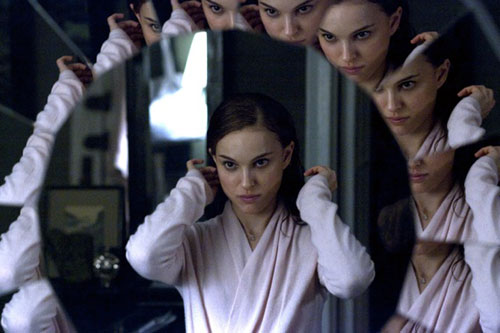 |
"Mirror mirror on the wall, who is the fairest of them all?"
The body is on constant display, but is not necessarily inhabited. It is, in the case of Nina, the ambitious heroine (Natalie Portman), secretly inhibited. Her quasi anorexic drive for perfection has kept her tied up in knots. She is her mother's "sweet girl" in stunted purity, all impulses repressed like the foot pressed into the tight box of the shoe. With her infantile voice, extreme shyness and awkwardness, Nina is all vulnerability, anguish and painful longing. She is so touching in her slightly stiff, withheld beauty that Thomas lets her try for the dream role: the Swan Queen in Swan Lake. But at the same time he throws her a challenge. Can she convincingly embody the Black Swan, her evil double? Can she seduce and sexually bewitch the Prince so he forgets the White Swan, his true love? Does she have it in her, somewhere beneath her chastity belt?
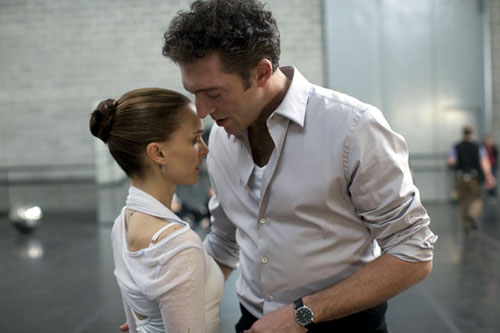 |
When you know the world of classical ballet you know this challenge is quite a conceit. Most ballerinas – just think of Margot Fonteyn – don't even dream of truly embodying evil or sexuality. They put on a black tutu and tiara and simply get through the challenging piqué balances, turns and fouettés of the role with forced bravura. (I have written in these pages about a rare exception from this rule, Cuban ballet star Lorena Feijoo, at San Francisco Ballet.) It is also a bit of a joke that company director Thomas proposes a "new" Swan Lake, "stripped down and visceral," when we are served the same marvelous, irreplaceable choreography we've always seen. But okay, it makes for a good story; this director's obsession with the Black Swan's sex appeal pushes the envelope and sweet little Nina has to push herself to interesting extremes to get there, to even keep the role -- against a rival dancer, Lily (Mila Kunis), who has two black wings tattooed on her back and comes from, yes, San Francisco. Lily, with her huge dark bedroom eyes, seems naturally born to the role.
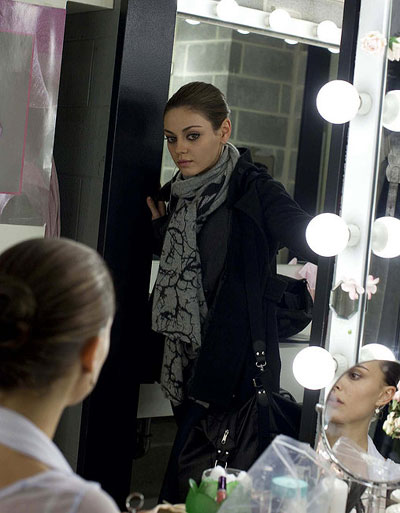 |
At one point, Thomas joins Nina watching Lily dance. Nina sees the difference, the gap she can hardly hope to fill, and Thomas, who says many intelligent things in this story, points out to her that Lily is imperfect in her movements but capable to let loose and forget herself, which is a condition of true perfection. "Sensuous. She isn't faking it," he concludes. Vincent Cassell (a star of French cinema, known for his roles of criminals and gangsters) delivers a rarity – a convincing portrait of a ballettomane, a man who doesn't accept obstacles in his passion. He is both annoyed and intrigued by Nina. Perhaps he senses her potential; in any case he uses every trick in the book– seduction, flattery, humiliation, bullying, provocation — to get what he wants. He starts by giving her "a little homework assignment: touch yourself. Live a little." Nina is mortified, and soon she hears the same "Live a little!" from Lily who has managed to get her away from mom's clutches and taken her to a disco in order to "relax" her with some speed and sex. This seduction happens on the very night before the opening of Swan Lake, when things are already at a breaking point. Does Lily, the understudy, want to help the "frigid little girl" or derail her so she can snatch her role?
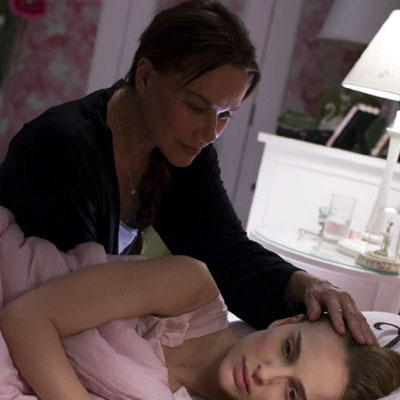 |
And Nina's mother (Barbara Hershey, looking like she had a monstrous skin disease), a failed ballet dancer who has no life apart from her daughter's career: does she really want her to rise to stardom or would she rather see her fail so Nina could stay the sweet girl, forever stuck in her little pink coat and pink room filled with plush toys, coddled, fed and suffocated by mother-love?
A scary mother, a scary rival, a scary puppet-master, all pressing in on the anxious, insecure dancer: it makes for a highly entertaining suspense story, and when the repressed feelings light up and explode, Black Swan can be enjoyed as a gothic tale or, if you prefer, a Freudian case story of classical hysteria: sexual repression and guilt breaking out in nasty bodily symptoms and finally discharging its tensions in violent resolve.
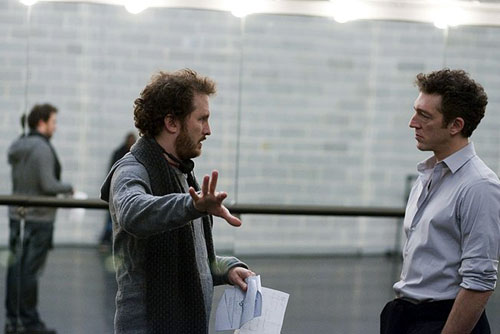 |
Everyone in the team is perfect – choreographer Benjamin Millepied (Portman's lover and the father of her child), costume designers Amy Westcott and the Rodarte fashion sisters (who designed the ballet wear), Winona Ryder as the dethroned, unhinged prima ballerina – but most of all Natalie Portman, although she is anything but a perfect dancer. No outsider morphs into a top ballerina for a movie -- in spite of Portman's childhood ballet lessons and a whole year of intense training. It takes a lifetime to grow the ballerina neck and the broad shoulders that allow an almost independent articulation of the arms. Portman's arms betray her; they are narrow, always too close to the body and stiff, whereas the rest of her body looks fine, thanks to computer technology and body doubles. The film quite cleverly avoids getting too precise about her dancing, and in a funny paradox her certain stiffness plays into the psychology of the inhibited ballerina. The real art of classical dancing is only suggested; its power resides in the music. The entire story is suffused by Tchaikovsky. His most haunting passages rise and fall like leitmotives, setting the mood for a scene or telling us what is really being said in the bits of dialogue we hear. The music, in turn, is enhanced by other sounds, especially the erotic sounds of breathing and heaving when dance sequences are shown. Black Swan may end up on the top music charts of 2011.
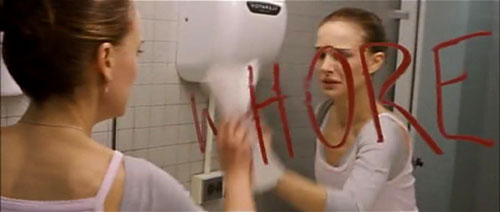
The rest – and that's a lot – is done by Natalie Portman's face, her subtle, fantastic acting. Aronofsky does something extraordinary with his lead actress, likening Black Swan to the great Hollywood star vehicles of a Garbo (Grand Hotel) or Marlene Dietrich, with their focus on a "divine" face. While our usual ballet experience tends to keep us far too distant from a ballerina onstage, here we get our fill of an intimate connection with beauty, with the permission to feel every emotion hidden or bursting from her face. The sudden spotlight on Portman as a superstar in the making came as a surprise for me. I hadn't noticed her storming out of the wings to the very top, perhaps because most of her movies were mediocre or violent or both (Goya's Ghost). From the moment she appeared as a twelve-year-old in the absurdly violent The Professional, her excellence has been overshadowed by the weakness of these films. Here she finally has a strong film, but it is a ballet film, which was a concern: "Everyone was so worried about who was going to want to see this movie," Portman told Entertainment Weekly. "I remember them being like, 'How do you get guys to a ballet movie? How do you get girls to a thriller?' And the answer is a lesbian scene. Everyone wants to see that."
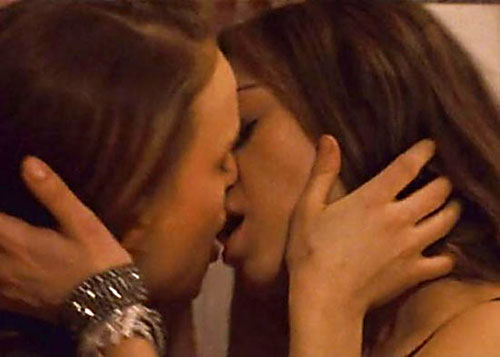
Black Swan's ending is ambiguous and mysterious as the ending to such a dark tale must be. Does Nina destroy herself like the dancer in that other famous ballet movie about ambivalence, The Red Shoes? Does she jump to her own destruction after her triumph, like another great heroine in opera's "shabby little shocker" Tosca? Nina does triumph: she pulls it off. She lets herself be possessed by the spirit of the Black Swan to the point where she feels her body literally taken over. It's a fantastic scene, getting high visual drama out of the famous 32 fouttés the dancer has to perform in order to seal the Black Swan's victory over the Prince, over love.
All of it, of course, is high drama and melodrama; the Gothic shock factor and violence are over the top and yet, of psychological and stylish coherence, making me think of certain works by Polanski and Cronenberg. The interest lies in the artistic question the story raises. What does it take for an ambitious artist to break free from insecurity, envious rage and repression? Aronofsky gets it exactly right: there has to be something excessive, over-the-top demented, in a great artist – something archetypal, right out of the cruel, magical world of fairytales.
|
|

